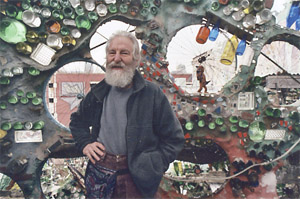
Isaiah and Julia Zagar arrived in Philadelphia in 1968, when the eastern end of South Street was decrepit. The two used the skills they learned in the Peace Corps in Peru to spark change in the neighborhood, which has flourished in the last 35 years.
Isaiah Zagar's Magic Garden and murals add glitter and sparkle to Philadelphia.
Related Story: Jowly Journeyman
image
TIMEOFF PHOTOS/SUSAN VAN DONGEN
Isaiah Zagar, the artist and his work.
Wow.
That's a frequently heard word around 10th and South streets in Philadelphia, specifically 1024-26 South St. This is the focal point for mosaic mural artist Isaiah Zagar, whose work has graced the exterior walls of numerous structures in the city for a couple of decades.
Born in Brooklyn in 1939, Mr. Zagar studied at Pratt Institute, graduating in 1960. While still a student, a friend took him to Woodstock, N.Y., to view the environment folk artist Clarence Schmidt had built over 40 years.
Seeing this inspired Mr. Zagar to think about his own environmental creations. But first, he traveled with his wife, Julia, to Peru to serve in the Peace Corps. They arrived in Philadelphia in 1968, when the eastern end of South Street was decrepit. The two used the skills they learned in the Peace Corps to spark change in the neighborhood, which has flourished in the last 35 years. In the late '70s, Mr. Zagar began to receive support from Philadelphia's mainstream arts community, and his work started to appear in exhibits and public projects, including the exterior of the Painted Bride Art Center at 230 Vine St.
He has his studio and residence around 10th and South, as well as the large parcel of land at 1024-26 called the "Magic Garden." It began as a place where he kept the stuff that goes into his walls and other creations — he calls them "poems." But in the last decade, especially, it's become a work of art in itself — a garden of assorted tiles, bicycle wheels, Central American pottery and ceramics, lawn sculpture, discarded dinnerware, bottles — especially cobalt blue and Heineken green — folk dolls and other flotsam. Even a few old toilets have found their way into Mr. Zagar's South Street garden. They're ceramic, after all, one of the materials he treasures for his works.

Isaiah Zagar's Magic Garden
And, of course, there are the mirrors. He certainly isn't superstitious because mirrors are one of his favorite things to break into pieces. They play a major part in his mosaics, making the walls gleam with bright colors and shiny surfaces.
It's the mirrors that give Mr. Zagar's creations an otherworldly quality. Even on a gray Philadelphia day, the structures he's adorned sparkle. On a sunny day, the pieces of mirror shoot prisms of light across the sidewalks and adjacent buildings.
Although Mr. Zagar's works are located throughout Bella Vista and Queen Village neighborhoods of Philadelphia, the Magic Garden is where the greatest "wow" factor can be found.
Living in Philadelphia from 1991 to 2000, I watched the Magic Garden evolve from a semi-vacant lot to a dazzling array of beautiful detritus. His work really took off after 1996, when Mr. Zagar was awarded a $50,000 Pew Grant.
Now, instead of just being a place for his stuff, the Magic Garden has become a magnet for the curious. It's all arches and structures that make a multi-story bower, adorned with tiles, ceramics, mirrors and other colorful materials.
The Magic Garden isn't open to passersby, but if Mr. Zagar is outside working, the gates will be open and visitors are free to enter and gawk at the glass and ceramic menagerie.
When the gate is closed, you can stand at the fence and stare for hours at the garden, trying to get your brain to catalog the details. Mr. Zagar likes to spell out names and "write" brief statements in painted tile across his murals, kind of like giant Scrabble tiles. The phrase "Art is the center of the real world" seems to be his mantra. It appears frequently in his works.
Another statement, "Some people like the money, some people like the honey, but I love art," tumbles across the western wall of the property.
The Magic Garden's murals — like Mr. Zagar's others — have many peaceful faces with benign eyes. Masks and heads are used quite a bit. Standing on the sidewalk, I found myself hunting for human elements within the jumble, like finding Waldo in the comic strip. I moved my eyes across the Magic Garden, maybe for half an hour or 45 minutes.
I saw a statuary lion's face draped by a dandelion leaf, a standing Buddha statue, which seemed to bless a little concrete kitty, and the arms on an ebony torso of a headless goddess reached for the sky while a white feline figure statue rested on her shoulder. "Does he plan this?" I wondered.
When I backed up to take a picture, a woman driving by slowed down, leaned out the window and asked, "What's this?"
"It's the Magic Garden," I said, and the magic worked on her. She pulled over, parked and joined me at the fence, and pretty soon she had the same look on her face.
"Wow," she said. Then she got out her cell-phone camera and took some digital pictures to send to herself at home, as well as friends in other locations. Now more people came by — a young Asian woman and her mother, who didn't speak much English. We communicated with them by pointing at the garden. "Oh, oh," the older woman said, smiling. Then they were hooked. Others joined us to linger.
There is no fee, but there are signs asking viewers to give a few dollars to help save the Magic Garden, which is endangered by the possibility of development.
For a couple of years, it's been rumored that the Boston-based owner of 1024-26 South St. wanted the garden gone so he could sell and "improve" on the property. The going price for the plot of land is $300,000. According to a November article in the Philadelphia Inquirer, the owner has ordered Mr. Zagar to remove everything on the site by May 23.
Recently, an anonymous benefactor has come forward with a two-year plan. If Mr. Zagar's nonprofit "Philadelphia's Magic Garden" can raise $200,000 in that time, the benefactor will put down the final $100,000, and the nonprofit will own the lot free and clear.
Civic leaders and a U.S. representative are trying to get the property owner to consider the benefits of the Magic Garden to the South Street neighborhood. Democrat Robert A. Brady has written to the owner about the non-monetary, artistic value of the garden, which he calls a "landmark and a city treasure."
Mr. Zagar's jewel is on a street that is becoming more and more commercial. Just in the last five years, many favorite places here have disappeared — the Montserrat bistro with its outdoor tables, Thrift for AIDS, and even the Book Trader has moved. I hope Isaiah Zagar's magical space can be saved before South Street turns into "Mall Street."
The Magic Garden, an installation in progress, mosaic mural and more by Isaiah Zagar, is located at 1024-26 South St., Philadelphia. To help save the space, call (215) 327-9911 or e-mail info@isaiahzagar.com. To inquire about making a tax-deductible donation, write to: Philadelphia's Magic Garden, 1003 Kater St., Phila., PA 19147, or stop by 1022 South St. Dozens of Mr. Zagar's mosaic murals can also be seen around this neighborhood. For an online map and more information about Mr. Zagar and his workshops, go to the Web site: www.isaiahzagar.org.
©PACKETONLINE News Classifieds Entertainment Business - Princeton and Central New Jersey 2005










